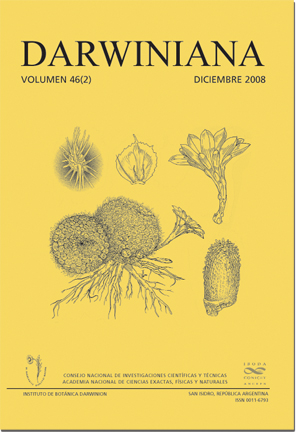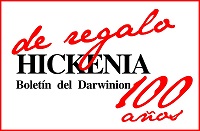CARACTERIZACIÓN CUANTITATIVA DE PRODUCTOS INTERMEDIOS Y RESIDUOS DERIVADOS DE ALIMENTOS DEL ALGARROBO (PROSOPIS FLEXUOSA Y P. CHILENSIS, FABACEAE): APROXIMACIÓN EXPERIMENTAL APLICADA A RESTOS ARQUEOBOTÁNICOS DESECADOS
DOI:
https://doi.org/10.14522/darwiniana.2014.462.282Palabras clave:
Argentina, arqueobotánica, Prosopis, Valle de HualfínResumen
Mediante una aproximación experimental se caracterizan los atributos macromorfológicos cuantitativos de productos intermedios y residuales derivados de Prosopis chilensis y P. flexuosa (Algarrobo blanco y Algarrobo negro respectivamente) que potencialmente podrían llegar a formar parte del registro arqueobotánico. Se provee descripción morfoanatómica de la vaina y la semilla de las especies tratadas. Se elaboró harina no refinada y refinada, añapa, aloja y arrope, siguiendo técnicas tradicionalmente utilizadas en el Valle de Hualfín, Catamarca, Argentina, las cuales fueron registradas por la autora en trabajos previos. Se concluye que el análisis cuantitativo de restos macrobotánicos de Prosopis, en conjunto con el cualitativo, permite la identificación de diferentes etapas de procesamiento del Algarrobo. Para ello resulta esencial la distinción entre las dos especies. La proporción de diferentes categorías de semillas y endocarpos es útil para distinguir la harina refinada de la no refinada. Esta última podría indicar la manufactura de patay, ulpo o aloja. Los residuos de la añapa y aloja se caracterizan por presentar semillas con testa plegada, enrollada o levantada, o carecer de ella, y sus cantidades se encuentran disminuidas o aumentadas con respecto a la cantidad inicial de harina utilizada dependiendo de si las semillas que se recuperan son enteras o fragmentadas. Los residuos del arrope se identifican por poseer grandes piezas de epicarpo y porque todos los endocarpos correspondientes a la cantidad de artejos utilizados inicialmente en su preparación se encuentran presentes. Dichos endocarpos se encuentran cerrados, y excepto en el caso de los residuos de arrope, se considera que la mayoría de las asociaciones arqueológicas de restos de Prosopis representa una proporción muy baja del volumen de materia que le dio origen en su contexto dinámico del pasado.Descargas
Publicado
31-12-2008
Cómo citar
Capparelli, A. (2008). CARACTERIZACIÓN CUANTITATIVA DE PRODUCTOS INTERMEDIOS Y RESIDUOS DERIVADOS DE ALIMENTOS DEL ALGARROBO (PROSOPIS FLEXUOSA Y P. CHILENSIS, FABACEAE): APROXIMACIÓN EXPERIMENTAL APLICADA A RESTOS ARQUEOBOTÁNICOS DESECADOS. Darwiniana, Nueva Serie, 46(2), 175–201. https://doi.org/10.14522/darwiniana.2014.462.282
Número
Sección
Arqueobotánica y Etnobotánica
Licencia

A partir de 2012, esta obra está licenciada bajo una Licencia Creative Commons Atribución-NoComercial 2.5 Argentina .
Cualquier obra derivada deberá estar previamente autorizada con nota escrita de los editores.







